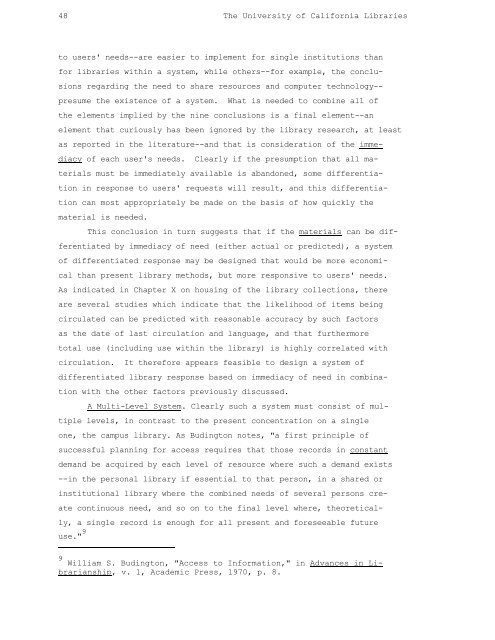The University of California Libraries: A Plan for Development (1977)
The University of California Libraries: A Plan for Development (1977)
The University of California Libraries: A Plan for Development (1977)
Create successful ePaper yourself
Turn your PDF publications into a flip-book with our unique Google optimized e-Paper software.
48 <strong>The</strong> <strong>University</strong> <strong>of</strong> <strong>Cali<strong>for</strong>nia</strong> <strong>Libraries</strong><br />
to users' needs--are easier to implement <strong>for</strong> single institutions than<br />
<strong>for</strong> libraries within a system, while others--<strong>for</strong> example, the conclusions<br />
regarding the need to share resources and computer technologypresume<br />
the existence <strong>of</strong> a system. What is needed to combine all <strong>of</strong><br />
the elements implied by the nine conclusions is a final element--an<br />
element that curiously has been ignored by the library research, at least<br />
as reported in the literature--and that is consideration <strong>of</strong> the immediacy<br />
<strong>of</strong> each user's needs. Clearly if the presumption that all materials<br />
must be immediately available is abandoned, some differentiation<br />
in response to users' requests will result, and this differentiation<br />
can most appropriately be made on the basis <strong>of</strong> how quickly the<br />
material is needed.<br />
This conclusion in turn suggests that if the materials can be differentiated<br />
by immediacy <strong>of</strong> need (either actual or predicted), a system<br />
<strong>of</strong> differentiated response may be designed that would be more economical<br />
than present library methods, but more responsive to users' needs.<br />
As indicated in Chapter X on housing <strong>of</strong> the library collections, there<br />
are several studies which indicate that the likelihood <strong>of</strong> items being<br />
circulated can be predicted with reasonable accuracy by such factors<br />
as the date <strong>of</strong> last circulation and language, and that furthermore<br />
total use (including use within the library) is highly correlated with<br />
circulation. It there<strong>for</strong>e appears feasible to design a system <strong>of</strong><br />
differentiated library response based on immediacy <strong>of</strong> need in combination<br />
with the other factors previously discussed.<br />
A Multi-Level System. Clearly such a system must consist <strong>of</strong> multiple<br />
levels, in contrast to the present concentration on a single<br />
one, the campus library. As Budington notes, "a first principle <strong>of</strong><br />
successful planning <strong>for</strong> access requires that those records in constant<br />
demand be acquired by each level <strong>of</strong> resource where such a demand exists<br />
--in the personal library if essential to that person, in a shared or<br />
institutional library where the combined needs <strong>of</strong> several persons create<br />
continuous need, and so on to the final level where, theoretically,<br />
a single record is enough <strong>for</strong> all present and <strong>for</strong>eseeable future<br />
use." 9<br />
9 William S. Budington, "Access to In<strong>for</strong>mation," in Advances in Librarianship,<br />
v. 1, Academic Press, 1970, p. 8.
















